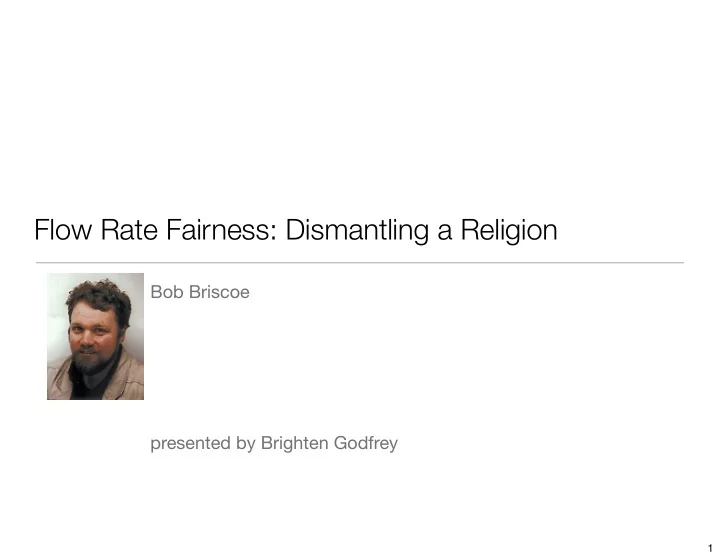

Flow Rate Fairness: Dismantling a Religion Bob Briscoe presented by Brighten Godfrey 1
Fairness in networks • Flow rate equality! 911 • Easily circumvented • Doesn’t even optimize for any metric of interest hotornot.com Fig. 1: Poppycock. 2
Fairness in real life • Plentiful resources: use as much as you want • e.g. air, advisor’s grant money • Scarce resources: pay for what you want • price set by market Fig. 2. Invisible hand • result (under assumptions): of the market. socially optimal allocation 3
Four main points • Flow rate fairness is not useful • Cost fairness is useful • Flow rate fairness is hard to enforce • Cost fairness is feasible to enforce 4
FRF is not meaningful or useful • It doesn’t measure benefits • e.g., SMS message vs. a packet of a video stream • It doesn’t measure costs • e.g., “parking lot” network: long flow causes significant congestion but is given equal rate by fair queueing • Therefore, doesn’t equalize cost or benefit 5
FRF is not meaningful or useful • Myopic: no notion of fairness across time congestion responses • Example: “TCP-fair” flows TCP-compatible ‘TCP-fair’ • Defined to get same aggregate rate as TCP across time flow rate, x(t) • But can be smoother congestion, p(t) • So they use less bandwidth t 1 t 2 time, t when resources are plentiful ( t 1 ) and more when resources are scarce ( t 2 ) –– hardly “fair”! 6
FRF is not meaningful or useful • In summary, FRF does not optimize utility (except for strange definitions of utility) • So, even cooperating entities should not want to use it! 7
Cost fairness is useful • Economic entities pay for the costs they incur • Note this is “fair” (in a real-world sense), not “equal”––and that’s fine • In other words, networks charge packets for the congestion they cause • Networks can easily lie about congestion! • So it’s really a market price, not exactly congestion • Result: senders want to maximize utility; since they are charged, they will seek to balance benefit with cost (utility = benefit - cost) 8
Cost fairness is provably useful • [Frank Kelly 1997]: Cost fairness maximizes aggregate utility • i.e.: any different outcome results in suboptimal utility • Why won’t anyone listen to Kelly? Hello??! ... where did everybody go? 9
Cost fairness is useful: example [Briscoe ’09] F)*;(4*. ,.4B>"2+4?. *,(#**/ 3? /)?,*"2+4?. (.B.4/.E 0#3?.+*)#3 N [ *)1. *)1. F)*;(4*. Z23$4)(Z"-UX"+,4()3? *)1. F)*;(4*. A.)?,*.E""-UX"+,4()3? Key point: Benefit per bit his high for light flow and low for *)1. *,(#**/)3?",.4B> 2+4?. heavy flow. 10
Four main points • Flow rate fairness is not useful • Cost fairness is useful • Flow rate fairness is hard to enforce • Cost fairness is feasible to enforce 11
FRF is hard to enforce • Just run your flow longer • Create more flows (sybil attack) • More TCP flows between same source/destination (web browsers) • Spoof source IP / MAC address • Multiple flows to other destinations (BitTorrent) 12 �� � � � � � � � � � � � � � � � � � � � � � �
Cost fairness is feasible to enforce • You send me a packet; I handle delivery and charge you for it • How much do I charge? Depends on You (src.) Dest. cost on entire remainder of path! $$ $$ $$ • The next hop I send it to is going to Me charge me, so I need to know how much, so I can cover my cost with your payment • Not the only way of arranging payments, but it is convenient (payments between neighbors that already have an economic relationship 13
Implementation: Re-Feedback [SIGCOMM’05] • Key property: every hop knows total congestion along downstream path 49 First packet $ 100 49 100 50 0 Second packet $ 51 0 51 1 14
Other issues • What about other notions of fairness used simultaneously? • That’s fine, but in the end someone pays • User interface • Price may be changing quickly • Can be fixed by paying for a block of “congestion credits for a month (say) 15
Conclusion • “It just isn’t realistic to create a system the size of the Internet and define fairness within the system without reference to fairness outside the system.” • Cost fairness optimizes aggregate utility and is feasible to enforce • Flow rate fairness does not optimize utility and is not feasible to enforce • Cease publication on the topic and stop teaching it in undergraduate courses 16
Discussion • In light of this paper, what use is (weighted) fair queueing? • If you were redesigning the Internet, would you use this general approach? • Security implications? • Bots may now effectively have access to micropayments 17
Recommend
More recommend